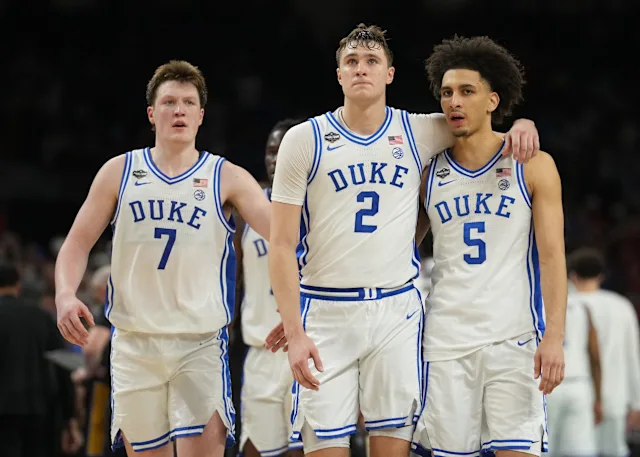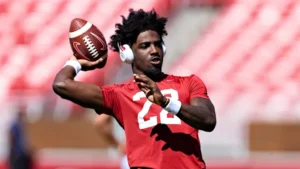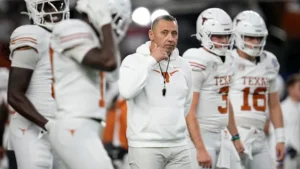
Life Without Flagg: Forecasting Duke Basketball’s 2025-26 Roster if Cooper Flagg Goes Pro
Duke basketball fans have spent the past year watching Cooper Flagg captivate the college hoops world. The once-in-a-generation prospect has lived up to the hype in every way—highlight-reel blocks, deep threes, and a two-way motor that never quits. But as the 2024-25 season winds down and Flagg’s NBA future looms, the question no one in Durham wants to ask becomes unavoidable: What will the Blue Devils look like in 2025-26 if Cooper Flagg declares for the draft?
It’s not just a hypothetical anymore. Flagg is widely projected to be the No. 1 pick in the 2025 NBA Draft, and barring a stunning return, Duke is preparing for a post-Flagg era. And while losing a talent of his caliber would be a seismic shift for any program, Duke might be better positioned than most to withstand it. Jon Scheyer and his staff have quietly assembled a mix of incoming talent, returning veterans, and transfer targets that could form the backbone of a competitive roster—even without its brightest star.
For starters, Duke’s recruiting pipeline continues to flow. The 2025 class already features commitments from five-star forward Cayden Boozer and four-star guard Jordan Smith. Boozer, the son of former Duke great Carlos Boozer, brings size, scoring, and championship pedigree. At 6-foot-9, he may not have Flagg’s transcendent athleticism, but he’s a polished forward who can stretch the floor and bang down low. Smith, meanwhile, is a dynamic scorer with a quick first step and a solid outside shot. He’s not the same kind of defensive anchor Flagg was, but he adds versatility and backcourt depth.
Then there’s the matter of returning players. Tyrese Proctor is expected to enter the 2025 NBA Draft, but should he shock observers by staying another year, Duke would gain a vital playmaker and leader. More likely, however, is that the Blue Devils will build around the next wave of talent—players like Caleb Foster, Jared McCain (if he stays), and Sean Stewart. Foster showed flashes of brilliance this past season, especially in pick-and-roll situations. Stewart, meanwhile, brings energy and rebounding, and with another offseason of development, could emerge as a legitimate double-double threat.
Jared McCain is the true wildcard. If he returns for a junior season, Duke gets one of the most electric scorers in college basketball back. McCain’s ability to heat up from beyond the arc and create off the bounce is elite. His leadership and infectious personality would also help fill the void left by Flagg. Should McCain leave, the onus falls even heavier on the incoming freshman and potential transfers.
That leads us to the transfer portal. Scheyer has shown a willingness to dip into the portal when needed, and the 2025 offseason should be no exception. While Duke hasn’t been a portal-heavy team in recent years, the landscape of college basketball is changing. Adding a veteran presence—perhaps a stretch four or a defensive-minded big—would go a long way toward stabilizing the lineup.
The frontcourt would be the area most impacted by Flagg’s departure. Without him, Duke loses a rim protector, a defensive quarterback, and a reliable scorer. That opens up a major opportunity for players like Christian Reeves or incoming freshman Khaman Maluach to step into bigger roles. Reeves, who’s battled injuries, has shown flashes of shot-blocking and rebounding ability. If healthy, he could help fill the paint defensively. Maluach, a 7-footer from South Sudan, brings size and raw athleticism. He’s still developing his offensive game, but his potential as a rebounder and shot-blocker is sky-high.
In the backcourt, Duke’s outlook is more stable. Even without Proctor or McCain, there’s depth. Jayden Harris, a potential breakout sophomore, has the tools to become a high-level scorer. Harris didn’t see much action in his freshman season, but those close to the program say he’s ready to make the leap. Jordan Smith will be thrown into the fire early, but he has the poise and skillset to hold his own. Pair him with someone like Foster or Harris, and Duke suddenly has a quick, aggressive backcourt capable of playing at pace.
What Duke may lack next season is a definitive go-to star. Flagg was that guy in 2024-25—a player you could count on to deliver when everything else broke down. In his absence, the Blue Devils will need to shift to a more balanced, team-first approach. That could mean more ball movement, more defensive switches, and a greater emphasis on offensive rebounding and transition play.
Scheyer’s system has always thrived when players buy in, regardless of pedigree. He’ll need to coach this group harder than ever, and his ability to get role players to overachieve will be tested. But there’s precedent. The 2022-23 and 2023-24 Duke teams were successful not because they had one star, but because they played as a unit. That same blueprint could apply next year.
Another factor to consider is leadership. Flagg, despite his youth, carried himself with a maturity beyond his years. Replacing that presence in the locker room won’t be easy. If McCain stays, he’s the natural successor. If not, someone else must rise—perhaps Boozer, despite being a freshman. His father’s influence and familiarity with the Duke culture could help him step into that role more quickly than most newcomers.
Recruiting isn’t done yet either. The 2025 class is still open, and with Flagg likely off to the pros, Duke has room to pursue another five-star talent or a high-impact portal addition. Don’t be surprised if Scheyer targets another forward—someone with size and versatility to help offset Flagg’s absence.
Off the court, the brand remains strong. Duke basketball is still Duke basketball. The recruiting pitch doesn’t change: top competition, elite facilities, national spotlight, and a fast track to the NBA. While losing Flagg is a blow to the immediate roster, it doesn’t set the program back long term. In fact, his success could strengthen the Blue Devils’ appeal to the next wave of stars.
From a fan perspective, expectations may need to recalibrate slightly. The 2024-25 team had Final Four aspirations largely because of Flagg’s presence. Without him, the 2025-26 squad might be more of a top-10 or Sweet 16 ceiling type—at least on paper. But that doesn’t mean they’re out of the national conversation. College basketball is increasingly unpredictable, and chemistry often trumps raw talent. If the pieces fit, Duke can still make noise.
There’s also something freeing about moving into a new era. For the past two years, everything revolved around Flagg—from the offense to the marketing campaigns. His shadow is enormous, and replacing him one-for-one is impossible. But in his absence, other players will emerge. Roles will change. The team’s identity will evolve. And that’s not necessarily a bad thing.
Jon Scheyer has proven he can adapt. He’s recruited well, developed talent, and shown growth as an in-game coach. The 2025-26 season, more than any before, will test his ability to build a cohesive unit without a clear superstar. But if he succeeds, it could be his most impressive coaching job yet.
So, what will Duke basketball’s 2025-26 roster look like without Cooper Flagg? It’ll be younger, less heralded, and perhaps more reliant on depth than dominance. But it will also be hungry, athletic, and filled with players eager to prove they can win on the biggest stage—together. The next chapter in Duke’s storied legacy might not feature its biggest name, but it still promises plenty of excitement. And in Cameron Indoor Stadium, that’s never in short supply.





